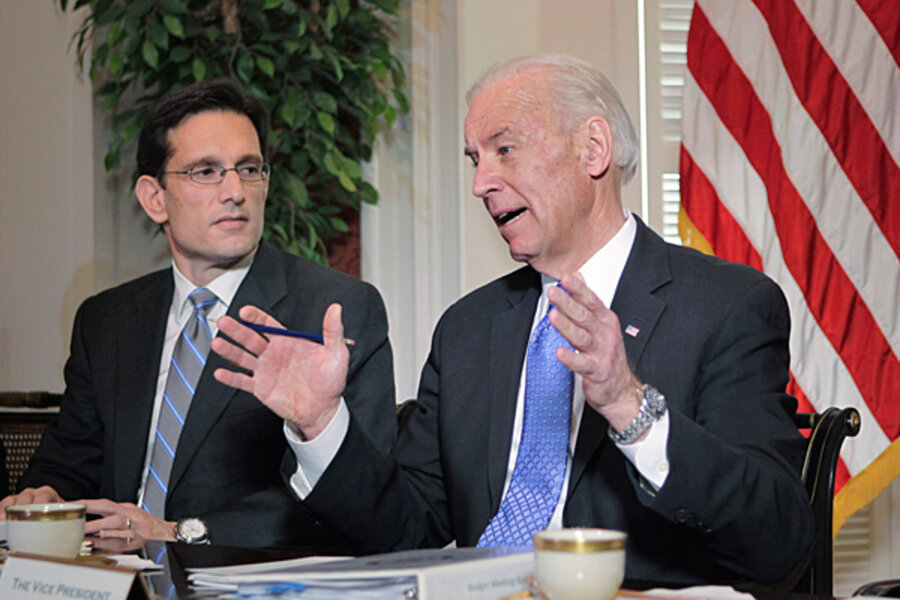Talks begin on deficit reduction. What can be cut in the federal budget?
Loading...
The goal of curbing federal deficits returned to the political forefront this week, as Vice President Joe Biden hosted a meeting on the subject Thursday with lawmakers from both parties.
It's an objective that's vital for America's long-term economic health, but difficult to achieve politically.
The persistent deficits, after all, stem largely from things that most Americans support – such as low tax rates and government-supported medical care for seniors.
At the same time, a political climate filled with warnings about the perils of the status quo has pushed key players to the bargaining table. So has a looming need for Congress to review the nation's debt ceiling (a cap on US Treasury borrowing). Many members of Congress don't want to raise that limit without showing some progress toward a more sustainable fiscal path.
Mr. Biden, acknowledging Republican pressure on this front, said a debt ceiling vote is "practically and politically connected" to plans for deficit reduction.
Moreover, Rep. Dave Camp (R) of Michigan, who chairs the House Ways and Means Committee, said he wants to move beyond "laying down more markers" and find areas of agreement in the federal budget. "Let's figure out where there is common ground and let's get there as soon as we can," Representative Camp said, according to the Associated Press.
At present, the words "Medicare" and "common ground" aren't being uttered in the same phrase. But entitlement programs aren't the whole federal budget. So the potential for a deal that puts a considerable dent in future deficits still exists.
Here's the background. In 2010, some 55 percent of all federal spending was "mandatory," for programs that run pretty much on autopilot according to laws passed by Congress. Those programs include the biggies – Social Security, Medicare, and Medicaid – as well as unemployment insurance and other programs.
Twenty percent of the federal spending was on national security, while 19 percent went for domestic discretionary purposes, according to the nonpartisan Congressional Budget Office. The final 6 percent was for interest on the national debt.
Since mandatory spending (and related interest on debt) is both the largest and the fastest-growing portion of the budget, Congress ultimately can't avoid dealing with the challenges there.
Still, a bipartisan fiscal commission appointed by President Obama charted a plan (which was released late last year) to cut federal deficits over the next 10 years nearly in half – from about $9.5 trillion (a cumulative 10-year number) to $5.3 trillion. Those numbers come from a new analysis of the plan by a nonpartisan group, the Committee for a Responsible Federal Budget.
Many budget experts say that deficit cuts of that magnitude would be a credible fiscal plan – one that would cause the national debt to start declining as a share of gross domestic product (GDP).
The fiscal commission's plan included two things that don't seem likely to emerge as part of a Biden-brokered plan. One is entitlement reforms, where the two sides have sharp differences. The other is tax-revenue increases, something most Republicans refuse to consider.
Still, of about $4 trillion in deficit reduction that the fiscal commission called for, about 43 percent could be achieved without changes to health-care programs, Social Security, or tax revenues. Those savings would stem from a cap on the growth of discretionary spending, cuts in projected spending on defense, changes in some mandatory spending (including federal retirement benefits), and a related decline in expected interest on the national debt.
The point isn't that leaders of both parties are likely to rally around those portions of the fiscal commission plan in their entirety, but that sizable deficit reduction is possible. Many moves that are small in isolation could, together, put a big dent in annual deficits.
Here are some of the spending-cut options -- excluding health care and Social Security – that have been examined by the Congressional Budget Office, with 10-year savings estimates:
• Reduce farm-subsidy programs: $40.4 billion.
• Lower the size of home loans to be guaranteed by Fannie Mae and Freddie Mac: $30 billion.
• Change interest-rate structure on student loans: $52 billion.
• Freeze defense spending at 2011 levels: $691.3 billion. (Defense cuts of a similar magnitude, $572 billion, are envisioned by the fiscal commission.)
• Reduce pay adjustments for federal employees: $50.7 billion.
• Restrain growth of National Institutes of Health budget to the rate of inflation: $42.8 billion.
• Cut federal support for arts and humanities (public broadcasting falls in this category) by 25 percent: $5.3 billion.
• Increase fees for aviation security: $20.8 billion.
• Limit highway funding to expected Highway Trust Fund revenues (from fuel taxes): $108.1 billion.
• Eliminate grants for waste-water and drinking-water infrastructure: $36.5 billion.
• Eliminate intercity rail subsidies: $44.7 billion.
• Eliminate funding for national community-service programs: $12.1 billion.
Many of these cuts would produce their own political controversies, but don't be surprised if some of them show up in news reports over the next month or so.
Biden said participants in the new bipartisan discussion will meet again next Tuesday, after what he called a constructive meeting on Thursday.





